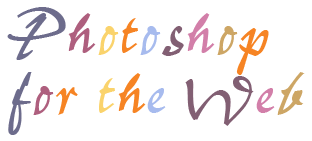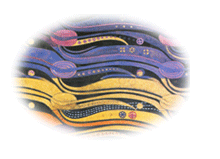
Weeks 5 & 6 Review Questions
- What's the difference between Lossy and Lossless compression?
Lossy compression, used for jpeg images, discards non-essential colour information that the eye won't miss, whereas lossless compression, used for gif graphics, retains the same properties of the image after compression, by compressing colour information for areas of an image where the colour is the same. - What file format would you choose to save a vector graphic that had only 15 colors? gif
- Describe two major differences between the JPEG and the GIF.
- Jpegs are used for photographs & images that use gradients & complex colours, whereas the gif format is used for graphics which have large areas of similar colour, such as logos, buttons, icons & text.
- Gifs support transparency & animation, but jpegs do not.
- Explain in your own words what color bit depth is.
Colour bit depth or colour resolution refers to the number of bits (binary digits: 1/0, on/off, yes/no, smallest unit of data) for each colour channel that can be displayed by a monitor. The more bits there are, the more colours that can be shown on a monitor. - What is Dithering?
Because all monitors do not display the same amount of colour, browsers, Photoshop & other software use 'dithering' as a way of compensating, by mixing colours that are present to simulate ones that aren't. - Explain what the 256 Web-safe color palette is and what it's used for.
The web-safe colour palette is a palette of 256 colours that can be accurately displayed on a an 8-bit monitor; it's used by web designers to cater for those, now few, users who only have 8-bit monitors. (2% in Jan 2008) It might also be used for some users with hand-held devices some of which only support 8-bit mode.- Describe what the term Gamma refers to.
Gamma refers to the brightness of the midtones of an image- What is the recommended Gamma value for graphics? 2.2
- How can Photoshop help you compensate for Gamma variations?
You can minimise the variations in brightness between Windows & Mackintosh computers, by adjusting the Gamma setting which alters the midtones of an graphic by using an adjustment layer of levels & altering the gamma setting to 0.75 / 0.8.- Describe in your own words what weighted optimization is.
Weighted optimization enables you to save jpegs using different compression rates for different areas of an image.- Please briefly explain how to implement weighted optimization.
You can implement weighted optimisation by selecting different parts of an image & using a mask to control which areas of the image receive the highest quality settings & which receive the lowest quality settings. The selection is then saved as a channel; in the 'Save for Web' dialogue box, select the jpeg file format & then choose the 'Use a Channel to modify the Quality' icon to adjust the quality settings in the 'Modify Quality Setting' dialogue box. The overall image can be saved with a particular quality setting, & then images within it that are masked can be given different setting.- True or False: Both the JPEG and the GIF implement a weighted optimization option for the Lossy setting
True: By selecting this option for the gif format it's possible to further reduce file size by between 5% - 40%.- What type(s) of compression does the GIF format use?
Lossless, but lossy compression can also be used within the 'Save for Web' >> optimise tab.- What is a CLUT?
Colour Look-Up Table, which is used by the gif format to identify the colour values of an image.- What does the term Index, in reference to the GIF, refer to?
When compressing a gif image using the CLUT format, a table is generated that acts as an 'index' of colour information; the index is used to identify areas of an image where the colour is the same, so that they can be compressed in order to reduce the file size. - Describe what the term Gamma refers to.
Photoshop CS2
Web design: Patsy James
